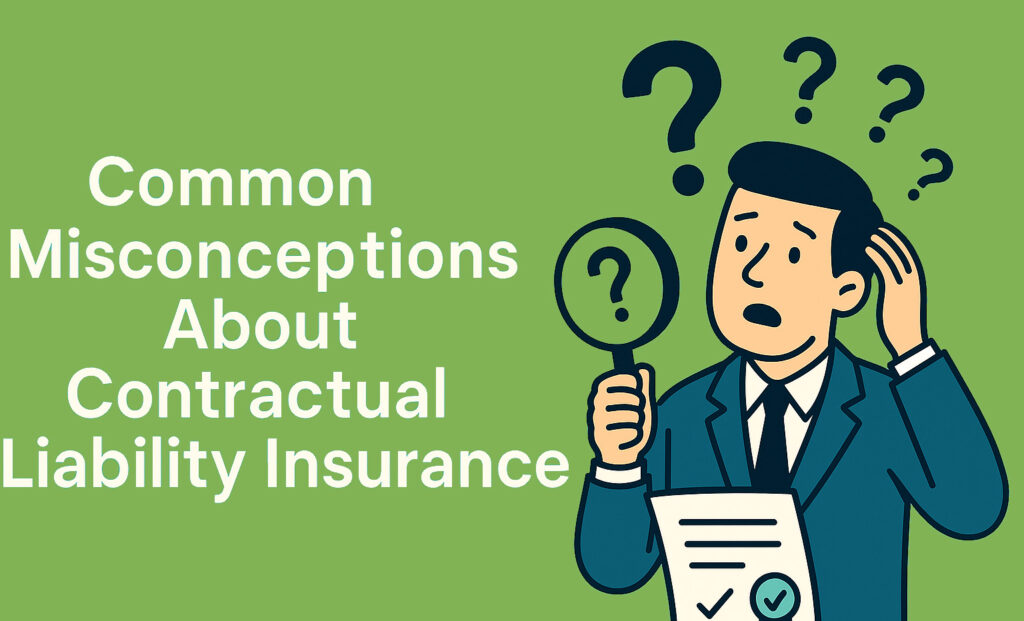Navigating the Complexities of Contractual Liability Insurance

Understanding insurance can often be overwhelming, particularly when it involves contractual liability insurance. This specialized form of contract insurance is essential for businesses, as it protects against potential financial losses arising from liabilities assumed within contracts. Liability insurance contracts play a crucial role in managing risks associated with contractual obligations.
But what is contractual insurance precisely? How does it differ from general liability insurance? And why is it particularly significant in the context of small business liability insurance?
This article aims to answer these questions clearly, exploring the details of contractual risk transfer and guiding you on effectively obtaining and utilizing insurance for contractual liability. Whether you’re a business owner, a contract manager, or a legal professional, this guide will provide the insights necessary to navigate contractual liability insurance.
What Is Contractual Liability Insurance?

Contractual liability insurance is specialized coverage designed to protect businesses against liabilities specifically assumed in contracts, typically through indemnity agreements. Such insurance becomes especially critical when a company agrees to indemnify another party within contractual terms. The objective is to shield businesses from financial risks associated with these agreements.
At its core, a contractual liability insurance definition encompasses coverage for liabilities explicitly assumed under contractual arrangements, such as construction contracts, service agreements, or lease agreements. The fundamental principle is to ensure businesses are not left exposed to financial risks because of promises made in contracts.
Contractual insurance coverage differs from general liability insurance. A CGL policy (Commercial General Liability policy) typically covers regular business risks, such as third-party bodily injuries or third-party property damage related to normal operations. Contractual liability insurance, however, specifically addresses liabilities explicitly outlined in contracts. For example, if a business promises to hold another party harmless for specific incidents under a hold harmless agreement, contractual liability insurance covers this promise.
Understanding the detailed terms and conditions of contractual liability insurance policies is vital. These policies specify exactly what liabilities are covered or excluded. Businesses must review these details to avoid surprises during liability claims. Insurance exclusions play a significant role in determining the scope of coverage, so it’s crucial to be aware of any contractual liability exclusions in the policy.
A significant advantage of holding this insurance is peace of mind. Businesses can confidently enter contractual agreements, knowing they have coverage against potential liabilities, leading to smoother business relationships and negotiations.
Moreover, contractual liability insurance plays an integral role in risk management strategies. As part of a comprehensive risk management portfolio, it ensures business stability and operational continuity when managing contractual commitments.
Understanding Contractual Liability in Insurance

Contractual liability in insurance refers to the liabilities a business assumes through contracts, frequently via indemnity clauses. These clauses require one party to accept liability for another, often referred to as an assumption of liability. Recognizing these obligations is critical when businesses enter various contracts, helping to determine the necessity of insurance for contractual liability.
Contractual insurance covers obligations not typically included in CGL policies. General liability insurance addresses direct claims like slip-and-fall accidents, whereas contractual liability handles indirect obligations, requiring a business to cover another party’s liabilities. This coverage is especially critical in industries such as construction or real estate, where contractual obligations are common.
Navigating contractual liability effectively requires thorough understanding of contract language. Contracts must be carefully reviewed to identify potential liabilities, ensuring protection against unforeseen financial consequences. This includes being aware of contractual liabilities examples to better understand the risks involved.
Another crucial aspect is identifying the scope of coverage. Businesses must ensure alignment between contractual obligations and insurance policies to avoid coverage gaps. Proper alignment offers essential protection and security, particularly in cases of liability assumed by contract.
Key Features
A key feature of contractual liability insurance is coverage of indemnity obligations, protecting businesses that assume liabilities through contracts. This feature is especially important in agreements containing an indemnity agreement or an insured contract clause.
Additionally, the policy can cover defense costs arising from legal proceedings related to indemnity obligations. Contractual liability insurance absorbs these legal expenses, protecting the business financially, especially during disputes or breach of contract claims.
Some policies offer flexibility, allowing adaptation to specific industries and contract types. Customized policies ensure appropriate coverage tailored to the contractual obligations of each business.
Importance of Coverage
The significance of having contractual liability insurance cannot be overstated. Without proper coverage, businesses face considerable risks in contractual arrangements. Costs associated with indemnity obligations can be overwhelming without this protective coverage, potentially leading to significant financial risk.
Contractual liability insurance enhances a company’s risk management approach, effectively mitigating risks. This proactive strategy ensures operational stability and contributes to long-term success by safeguarding against potential legal obligations arising from contracts.
Holding this insurance can also provide a competitive edge. Clients and partners view insurance coverage as evidence of reliability and financial responsibility, strengthening business relationships and creating opportunities.
Contractual Risk Transfer Explained

Contractual risk transfer involves shifting potential liabilities from one party to another through contracts. Businesses utilize these transfers to minimize financial exposure from risks during contractual operations, particularly in higher-risk industries like construction and manufacturing.
The primary aim of contractual risk transfer is to protect company assets by limiting direct exposure. Transfers are executed through detailed clauses specifying liability responsibilities, clearly defining roles and reducing potential disputes.
Definition and Mechanism
Contractual risk transfer occurs when potential liabilities shift from one party to another, typically via indemnity clauses. These clauses outline liability compensation agreements crucial in complex contracts.
This mechanism identifies potential risks and assigns responsibility, essential for preventing disputes. Insurance supports the financial aspects of risk transfer, providing confidence in managing contractual obligations.
Examples of Risk Transfer in Contracts
Risk transfer frequently appears in construction contracts, where subcontractors assume specific risks from main contractors. For example, a plumbing subcontractor might accept responsibility for leaks caused by their work, supported by contractual clauses and insurance.
Service agreements commonly use risk transfer. A cleaning company might indemnify an office for injuries caused during cleaning, shifting liability away from the office owner.
Lease agreements also demonstrate risk transfer, requiring tenants to maintain liability insurance for small business as part of the agreement, assigning them responsibility for certain damages. This is a common contractual liabilities example in the real estate sector.
Common Misconceptions About Contractual Liability Insurance

Contractual liability insurance is often misunderstood. One common misconception is that it offers blanket contractual liability coverage. Instead, it covers liabilities specifically assumed in contracts, distinct from general liability insurance.
Another misconception is that contractual liability coverage is redundant if a business already has a CGL policy. General liability policies might not include liabilities assumed by contracts, leaving coverage gaps contractual liability insurance can fill. It’s important to note that there may be a contractual liability exclusion in standard CGL policies, making separate contractual liability coverage necessary.
Lastly, some think this insurance is only for large corporations. However, small businesses significantly benefit from contractual liability insurance due to limited resources to cover potential losses, making proper coverage crucial.
How to Assess Your Need for Contractual Liability Coverage
Assess your need for contractual liability insurance by reviewing contracts for indemnification clauses. Consider your industry’s typical risks, particularly in high-risk sectors such as construction.
Evaluate business size; smaller enterprises typically need liability insurance for small business due to limited financial resilience. Examine historical claims for patterns indicating potential vulnerabilities in your risk management.
Understand unique contractual obligations and practices, especially in international contracts. Consider negotiating additional insured endorsements or increased policy limits, ensuring your coverage matches business needs.
Conclusion and Next Steps

Contractual liability insurance is essential in protecting businesses against financial risks from contractual obligations. Engage with experienced professionals to understand contractual liability meaning, broad form contractual liability, and navigate exclusions effectively.
Regularly review your coverage to maintain alignment with evolving business needs, considering blanket contractual liability endorsements or standard contractual liability endorsements. A contractual liability endorsement can provide crucial additional protection for your business.
By understanding the contractual liability definition and addressing financial consequences, businesses can enhance risk management, securing stable growth. Remember that proper insurance coverage is vital for managing liability assumed by contract and protecting against potential breach of contract claims.

